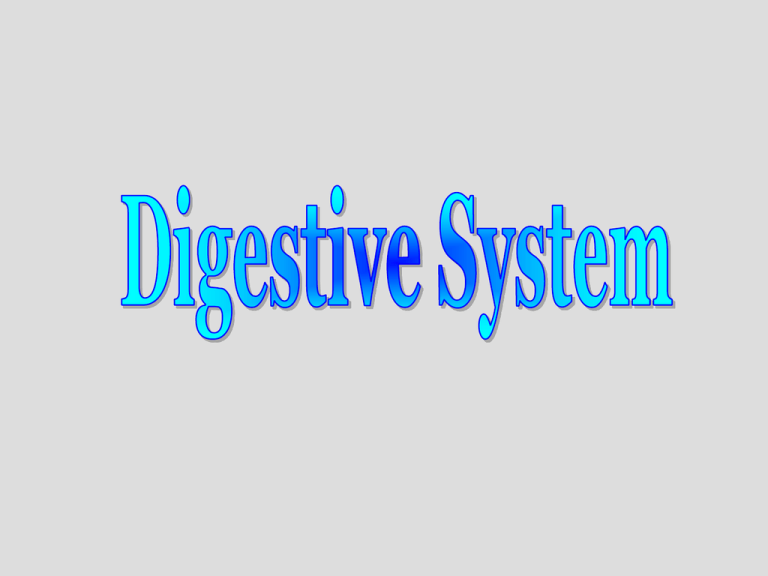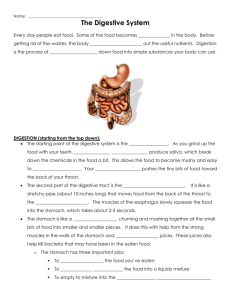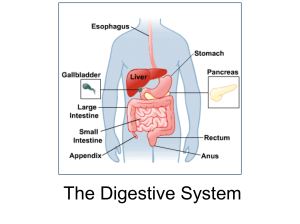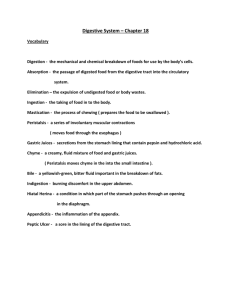Digestive_Lecture
advertisement

• Digestive system extends about 8 meters from the mouth to the anus, consisting of several accessory organs, which secrete substances that aid in the process of digestion. • Digestion- is the chemical and mechanical breakdown of foods and the absorption of nutrients by cells. – Mechanical digestion- breaking larger pieces into smaller ones without altering their chemical composition – Chemical digestion- breaks food into simpler chemicals. The organs of the digestive system carry out these processes. • At its simplest, the digestive system it is a tube running from mouth to anus. This tube is like an assembly line, or more properly, a dissembly line. • It is the process of turning food substances into sugars, amino acids, and fatty acids • The alimentary canal includes the mouth, pharynx, esophagus, stomach, small intestine, large intestine, rectum and anus. • Lumen- the opening/hole of the digestive tract • Peristalsis- propelling movement of food through the digestive tracts. When peristalsis occurs, a ring of contraction appears in the wall of the tube. At the same time, the muscular wall just ahead of the ring contracting ring relaxes. As the peristaltic waves move along, it pushes the contents ahead. • The peristaltic movement also aids in the process of digestion. • Remarkably diverse and specialized processes take place in different sections of the digestive tract, but there is a fundamental consistency in the architecture of the tubular digestive tract. With few exceptions, the wall of the digestive tube from the mouth to the anus is composed of four basic layers or tunics. Layers of the GI Tract • Mucosa- this innermost layer is responsible for absorption of nutrient. This layer is made of simple columnar epithelium and has numerous folds that increase the surface area for maximum absorption • Submucosa- the 2nd innermost layer that provides the blood supply. When nutrient are absorbs by the mucosa layer, they are transported to the submucosal layer where the will enter the blood supply. • Muscularis- the layer that is made of smooth muscle and is responsible for carrying out peristalsis. There are two layers of muscles; longitudinal and circular. • Serosa- the outer layer that is binds and protects the entire GI tract The lining of the epithelium of the outer lining of the mucosa function in absorbing nutrients and secreting mucus and digestive enzymes. Absorption of nutrients from food into the cells of the epithelium will eventually be transported through the circulatory system. Organs of the Digestive System and their Functions • Mouth • Digestion begins in the mouth. The mouth receives the food and begins digestion by mechanically reducing the size of solid particles and mixing them with saliva. • The tongue helps move food under the teeth as well as mix the food with saliva. • Salivary glands- secrete saliva, which contains enzymes, such as amylase, that initiate the breakdown of carbohydrates. • The mouth and the tongue roll the mixture into a mass, known as a bolus, and forces it into the pharynx • Once the flood leaves the mouth and is swallowed, the pharynx is responsible in connecting, the oral and nasal cavities to the esophagus in which the food will enter next. • Esophagus • The bolus will move through the esophagus and pass through the esophageal sphincter and empty into the stomach. The esophageal sphincter closes after the food passes through the stomach and remains that was until the food leaves the stomach preventing regurgitation. • Stomach • The stomach is a Jshaped organ that function to store food, initiate the digestion of proteins, kill bacteria with the strong acidity of gastric juices, and move the food into the small intestine as a pasty material known as chyme. • There are three regions of the stomach: fundus, body, and pylorus. • The stomach on average has a capacity of 1 liter. • The inner surface of the stomach is lined with long folds known as rugae. • The stomach churns the chyme mixing it thoroughly with gastic juices. The stomach secretes around 2-4 liters of gastric juices a day. • These gastric juices comes from microscopic holes found in the rugae known as gastric pits. Gastric “Juicy” • As food remains in the stomach for periods of time the stomach churns the food and mixes it with gastric juices that help liquefy the solid food into chyme; also initiating the breakdown of proteins • There are three main types of gastric glands: – Chief Cells – Parietal Cells – Mucous Cells • The combination of all of these chemicals is referred to as gastric juice, and has a pH of less than 2.0 What do these Gland Do? • Chief Cells- secrete digestive enzymes, pepsin • Parietal Cells- secrete HCl acid. – HCl acid and Pepsin work together to ultimately digest proteins • Mucous Cells-serve to protect the stomach from digesting itself • As these enzymes begin digestion and are being churned by the stomach, peristalsis forces the chyme begins to move toward the pyloric region of the stomach. The pyloric sphincter begins to relax enabling food to enter the small intestine a little at a time. The Food Now Enters the S.I. • The small intestine is approximately 18 feet long in a living person. • There are three regions of the small intestine: – Duodenum- makes up the first foot of the S.I. – Jejunum- makes up approximately the next 7 feet – Ileum- makes up the last 10 feet of the S.I. • Since the S.I.’s major function is to absorb nutrients, further digestion of proteins, carbohydrates, and fats begin. Lets Break it on Down • The S.I gets help from three important organs that will secrete more enzymes and juices to aid in the digestive process. – Liver – Gallbladder – Pancreas • These three organs secrete substances into the duodenum of the S.I. to breakdown food substances even more. • The liver and gallbladder have two ducts that join together to form the common bile duct. This duct empties bile into the duodenum of the S.I • The liver is found in the upper left quadrant of the abdominopelvic cavity produces bile, which is a yellowish-green color. • The gallbladder has a duct connected directly to the live. The bile that is produced in the liver is stored in the gallbladder. • Furthermore, the pancreas makes andsecretes enzymes that help digest fats, carbs, proteins and nucleic acids. These enzymes exit the pancreas and enter the duodenum of the S.I. at the same place that the common bile duct enters. The duct that carries this pancreatic juice is called the pancreatic duct. • Page 398 and 399 How the Liver, Gallbladder and Pancreas Work Together • The small intestine is held in place and supported by a double layered peritoneal membrane known as mesentery • The mesentery suspends the S.I.’s from the posterior wall as well as supplies the S.I. with its nerve and blood supply. • The chyme leaves the S.I through the ileum by passing through the ileocecal sphincter into the cecum of the large intestine. • The L.I. is about 4.5-5 feet long and is made of five segements: – Cecum – Ascending Colon, Transverse Colon, Descending Colon – Sigmoid Colon • The L.I.’s, (a.k.a “colon”), function is to absorbs water, electrolytes, and vitamins. • What the L.I. doesn’t absorb is known as feces. Its color and odor comes from the products of bacteria and bile.









